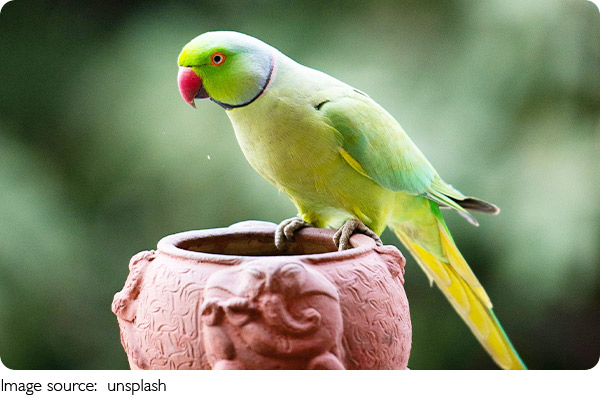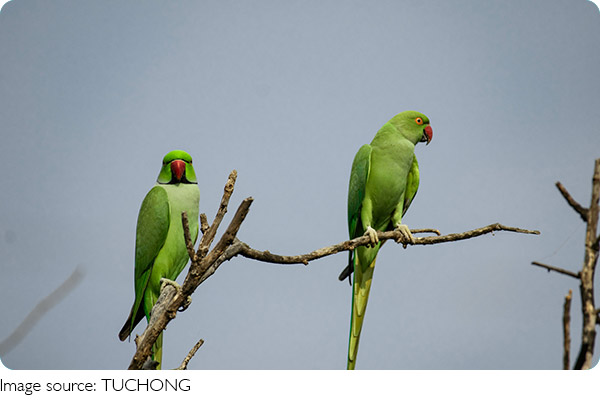Parrot Speech Secrets

Have you ever been amazed by how parrots can mimic human speech so accurately? Whether it's a simple "hello" or complex phrases, these feathered creatures seem to have a special talent for imitating our voices.
But how do they do it? What's happening in their brains that allows them to pick up on human language so effortlessly?
In this article, we'll dive into the science behind parrot speech and uncover the fascinating brain mechanisms that make it possible.
The Parrot's Unique Brain Structure
The secret to a parrot's speech lies in its brain structure. Unlike many other animals, parrots possess a unique region in their brain called the "vocal learning center." This area is key to the bird's ability to mimic sounds. It's similar to the speech centers in humans, but in parrots, it's more specialized. This vocal learning center allows them to process and produce sounds that are not innate to their species, including human speech.
What sets parrots apart from most other birds is their ability to imitate a wide range of sounds. Most birds have fixed calls that are part of their genetic makeup. Parrots, on the other hand, can learn new sounds throughout their lives, which makes them capable of mimicking human voices. This ability is also what allows them to adapt to different environments and communicate with humans.
The Role of the Syrinx
In addition to their unique brain structure, parrots have a special vocal instrument called the "syrinx." The syrinx is located at the base of their trachea and is responsible for producing sounds. Unlike humans, who rely on their vocal cords, parrots can control the syrinx with great precision, allowing them to produce a wide variety of sounds, including the nuances of human speech.
The syrinx is capable of producing complex vocalizations, and because parrots can control it so finely, they can match the pitch, tone, and rhythm of human voices. This gives them the ability to reproduce not just words but also the emotional tone behind those words, which is why parrots can sound like they're actually conversing with us!
How Parrots Learn to Mimic Speech
So, how do parrots actually learn to mimic human speech? It starts with the process of imitation. In the wild, parrots use their vocal abilities to communicate with their flock. They can learn to mimic the sounds of their environment, from other birds to natural sounds. When living with humans, they start to copy our voices as part of their socialization process.
Just like human babies, parrots need to hear sounds repeatedly to learn them. The more often they hear a specific word or phrase, the better they get at reproducing it. Some parrots may even develop preferences for certain sounds or words based on the tone and emotional context in which they hear them. They're keen listeners and are able to imitate the rhythm and melody of speech, not just the words.
Parrot Communication: More Than Just Mimicry
Interestingly, parrots don't just mimic for the purpose of copying. In many cases, they use human speech in their interactions with us. A parrot might greet its owner with a cheerful "hello," or it might say "goodbye" when someone leaves. This shows that parrots are not only capable of mimicking speech but also of using it as a form of communication, showing an understanding of social context.
In some cases, parrots have even been observed using words in ways that suggest they understand their meaning. For example, a parrot might say "want food" when it's hungry or "I love you" when it's seeking attention. While they may not fully grasp the nuances of human language, parrots do seem to have a basic understanding of how speech works in social interactions.

The Limitations of Parrot Speech
While parrots can mimic a wide variety of sounds, there are some limitations to their speech capabilities. For one, parrots do not understand language the way humans do. They can replicate the sounds but don't have a full grasp of grammar, sentence structure, or abstract concepts. Their communication is based on repetition and association rather than comprehension of language in its entirety.
Moreover, not all parrots are equally skilled at mimicking speech. Some parrots may pick up new words quickly, while others may struggle. The ability to mimic speech can depend on the parrot's species, age, personality, and the amount of time they spend around humans.
Conclusion: A Remarkable Talent
In conclusion, parrots' ability to mimic human speech is a truly remarkable skill that showcases the complexity of their brain structure and vocal organs. With their specialized vocal learning center and finely tuned syrinx, parrots are capable of reproducing sounds with impressive accuracy. While they don't fully understand language in the human sense, they use their speech abilities to communicate with us in ways that feel surprisingly meaningful.
Next time you hear a parrot speak, remember that it's not just mimicking—it's using its brainpower and vocal skills to engage with its environment in a fascinating way. Have you ever had a conversation with a parrot? Share your experiences with us in the comments below!
-
 Yawning Dogs ExplainedIs your dog yawning because they're tired or just imitating us? Find out what's behind the behavior!
Yawning Dogs ExplainedIs your dog yawning because they're tired or just imitating us? Find out what's behind the behavior! -
 Cats and GroomingDid you know that your cat's grooming routine isn't just for cleaning? It's also a form of mental therapy!
Cats and GroomingDid you know that your cat's grooming routine isn't just for cleaning? It's also a form of mental therapy! -
 Best Cats for WorkersLooking for the ideal cat to match your work schedule? These 5 cat breeds are perfect for busy professionals!
Best Cats for WorkersLooking for the ideal cat to match your work schedule? These 5 cat breeds are perfect for busy professionals!